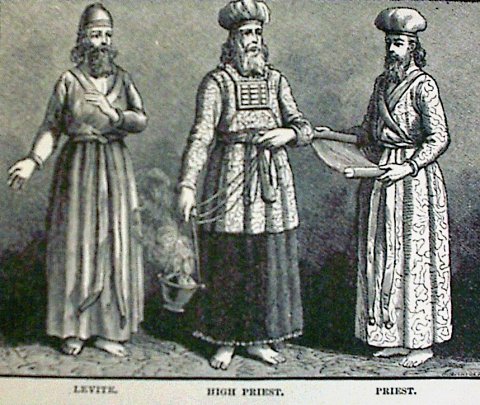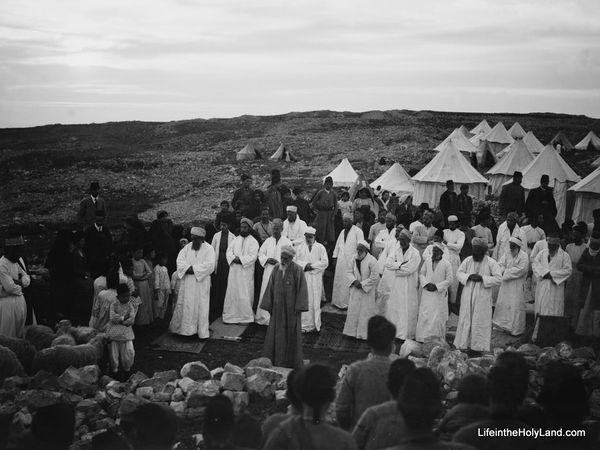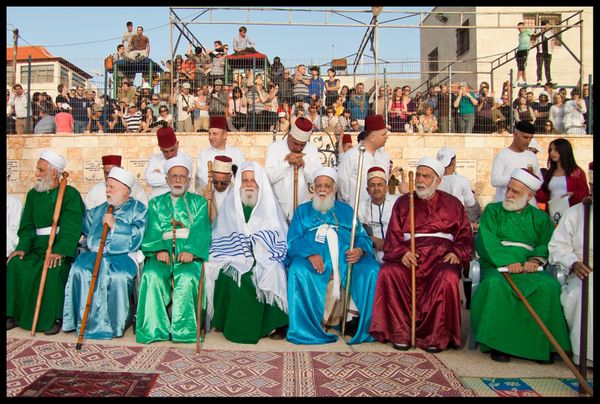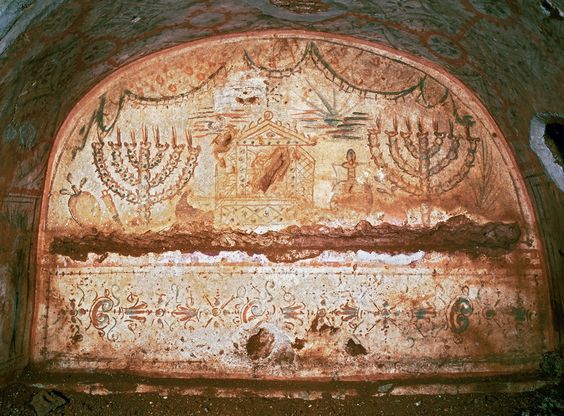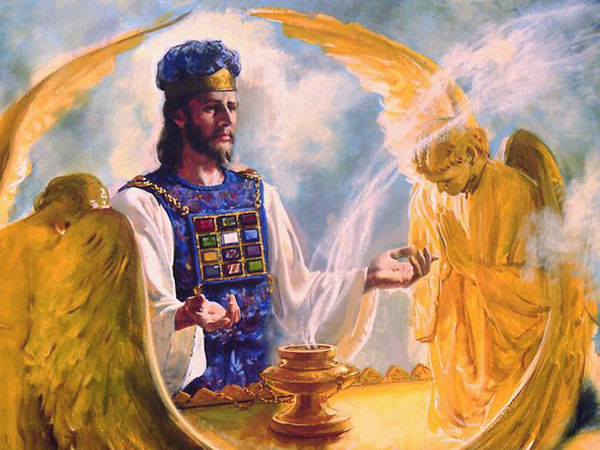Category:Priesthood (subject)
The Priesthood was one of the central institution in ancient Judaism.
Overview
In ancient Israel priesthood was inherited by birth. There were priestly families, who were regarded as descendants of the patriarch Levi according to a hierarchy of sons of Levi, sons of Aaron and sons of Phinehas.
The "biblical" Priesthood was preserved by the Samaritans, a group of Israelite living in Northern Israel (Samaria) who had separated from the Temple community of Jerusalem after the Babylonian exile. Today, the Samaritans are still performing the ancient rituals led by an hereditary priesthood.
Samaritans
Samaritan priests chanting
The Samatitans
After the destruction of the Temple, the Pharisees concluded that the obedience to the Torah had replaced the sacrifices in the Temple and the priesthood was no longer necessary, until the end of time. The authority of the priests was replaced by the authority of the rabbis. Priests however continue to have a place of honor and the Oral Law (Mishnah, Tosefta, Talmuds) deals extensively with Temple rituals.
The Christian believed that Jesus replaced the "old" priesthood as the new High Priest "according to the order of Melchizedek."
See Melchizedek
Priesthood in Rabbinic Judaism
After the destruction of the Temple, the role of the kohanim (priests) diminished significantly in favor of the rabbis. The Torah "replaced" the Temple as the center of Judaism, and the rabbis "replaced" the priests as the supreme authority in Judaism. Purity norms that in the Torah were limited to priests were extended to the entire people. However, the Levitical priesthood was not "replaced" by another priesthood and the rabbis continue to keep track of kohein lineage.
Kohanim were given an honorary status. They customarily given the first aliyah (i.e., opportunity to recite a blessing over the Torah reading and read from it) on the Sabbath and other days when the Torah is read in public, which is considered an honor. They are also required to recite a special blessing (Numbers 6,24-26) over the congregation in every morning prayer and in additional prayers.
The Oral Laws contains detailed regulations about the Temple and the priesthood.
Kodashim ("Holy Things") is the fifth of the six orders of the Mishnah (Tosefta, Talmud). It is entirely devoted to the Temple, the Priesthood, and the ritual slaughter of animals either for sacrifices or for non-sacrificial use.
Kodashim includes 11 tractates, as follows:
- 1. Zevachim (“Sacrifices”) deals with the sacrificial system of the Temple period.
- 2. Menachot ("Meal Offerings") deals with the rules regarding the preparation and presentation of grain-meal and drink offerings.
- 3. Hullin ("Ordinary or Mundane") deals with the laws for slaughtering animals and birds for meat for ordinary use, as opposed to sacred use.
- 4. Bekhorot ("Firstborns"), consists of nine chapters and deals mainly with the sanctification and redemption of human and animal firstborns.
- 5. Arakhin ("Dedications" or “Estimations”), with nine chapters, deals with the rules for determining the amount which must be paid in fulfillment of a vow.
- 6. Temurah ("Substitution") outlines the rules about the substitution of one sacrificial animal for another in accordance with the Torah’s instructions.
- 7. Keritot ("Excisions") deals with the transgressions for which the penalty is karet, meaning, sins punishable by premature or sudden death, or being cut off from the community of Israel, if done deliberately, and the type of sin-offering sacrifice that had to be offered to effect atonement if the transgression was committed in error.
- 8. Me'ilah (“Sacrilege” or "Trespass") deals with laws concerning disrespectful treatment of property belonging to the Temple or using holy objects in a prohibited manner, and with restitution for the misappropriation of Temple property (see Lev 5:15–16).
- 9. Tamid ("The Daily Sacrifice", lit. “The Continual [Offering]”) outlines the Temple service for the daily morning and evening sacrifice.
- 10. Middot ("Measurements" or “Dimensions”) containing descriptions of the Second Temple’s architecture.
- 11. Kinnim ("Nests") deals with the instructions regarding the offering of birds, in penitence for certain offenses and certain conditions of uncleanness.
As part of the Mishnah, Kodashim was compiled and edited between 200–220 CE by Rabbi Yehudah haNasi and his colleagues.
There is a Tosefta for the tractates Zevahim, Hullin, Bekhorot, Arakhin, Temurah, Me'ilah, and Keritot. Tamid, Middot and Kinnim have no Tosefta.
The Jerusalem Talmud has no Gemara (commentary) on any of the tractates of Kodashim.
In the Babylonian Talmud, all the tractates have Gemara for all their chapters except for Tamid which has it only for three chapters and Middot and Kinnim which don't have any.
Priesthood in Christianity
Christians believed that the old priesthood (the hereditary sons of Levi) was "abrogated" and replaced by a new priesthood "according to the order of Melchizedek."
See Hebrews 4:14ff.
Pages in category "Priesthood (subject)"
The following 17 pages are in this category, out of 17 total.
1
- Levitischer Hoherpriester und Priester (Levitical High Priest and Priests / 1695 Lund / Lund), book
- Die alten jüdischen Heiligthümer, Gottesdienste und Gewohnheiten (The Ancient Jewish Shrines, Worship and Habits / 1701 Lund / Muhle), book (revised ed.)
- Heiligdommen, godsdiensten, en gewoontens der oude Jooden = Die alten jüdischen Heiligthümer, Gottesdienste und Gewohnheiten (The Ancient Jewish Shrines, Worship and Habits / 1726 @1701 Lund, Muhle / Long, Outhof), book (Dutch ed.)
- Die Alten Jüdischen Heiligthümer, Gottesdienste und Gewohnheiten (The Ancient Jewish Shrines, Worship and Habits / 1738 Lund, Muhle / Wolf), book (revised ed.)
- A Study of the Zadokite High Priesthood within the Graeco-Roman Age (1961 Smith), thesis
- Aaron: eine Studie zur vorpriesterlichen Aaron-Uberlieferung (1978 Valentin), book
- Prêtres anciens, prêtre nouveau: selon le Nouveau Testament (1980 Vanhoye), book
- Sacerdotes antiguos, Sacerdote nuevo: según el Nuevo Testamento (1984 Vanhoye), book (Spanish ed.)
- Old Testament Priests and the New Priest: according to the New Testament (1986 Vanhoye), book (English ed.)
- Sage, Priest, Prophet (1995 Blenkinsopp), book
2
- Sapiente, sacerdote, profeta = Sage, Priest, Prophet (2005 Blenkinsopp / Pisi, Zoroddu), book (Italian ed.)
- The Development of the High Priesthood during the Pre-Hasmonean Period (2006 Brutti), book
- A Kingdom of Priests: Ancestry and Merit in Ancient Judaism (2006 Himmelfarb), book
- Tempio, culto e sacerdozio nel cristianesimo delle origini (2009 Pitta), edited volume
- Between Temple and Torah: Essays on Priests, Scribes, and Visionaries in the Second Temple Period and Beyond (2013 Himmelfarb), book
- Phinehas, the Sons of Zadok, and Melchizedek: Priestly Covenant in Late Second Temple Texts (2016 Chang), book
Media in category "Priesthood (subject)"
The following 3 files are in this category, out of 3 total.
- 1649 * Lightfoot.jpg 300 × 366; 27 KB
- 2010 Angel.jpg 333 × 499; 22 KB
- 2019 Cho.jpg 333 × 499; 24 KB
